Dream Machine
An artist with a difference on darts with Warney, Ten foot tall Thommo, and hitting the big time in America.
Jamie Cooper is not only one of Australia’s most successful commercial artists, but he played twenty-six games for Fitzroy at the highest level of Australian Rules Football. His dream scenes of the imagined meetings of legendary athletes have been commissioned in Europe, America and at home since the 90’s. Jamie is an avid sports storyteller and cricket tragic. He spoke to Cricket Et Al’s Dan Toomey at his studio.
There’s three distinctly bright red woollen footy jumpers at the entry to Jamie Cooper’s studio. Not replicas, the real deal - iconic Fitzroy emblem in the middle, large digits on the back. No ads. Clean as a whistle and in perfect nick.
About 22 yards away is a ten-foot-tall Jeff Thomson - barefoot, singletted, and wearing a friendly, knowing smile on a massive canvas that dominates the surprisingly empty studio.
Most artist spaces you see captured on the internet are filled with a kind of happy chaos of equipment, frames, easels and drawers. This one feels cavernous. Thomo could easily run the length unimpeded and ‘go wang’. ‘Thomo was my hero,’ Jamie explains. ‘Like he was a god (to me), you know’
Then Jamie starts talking about about how his subjects have been moving in the moment before being captured on his canvas, waving his arms to point the direction the ball came to Scott Pendlebury in the 2023 Grand Final, swinging them around to the corner of the studio to indicate the player Pendlebury saw that others didn’t. He draws his hands in to indicate how he moved the ball to shift a player before moving around them to deliver to his target.
He’s managed to fill the space with described action. I can see why he needs the room.
Cooper is, still, an athlete and uses the space to illustrate the movement of players within a game. He criss-crosses his arms, showing how he had the chance to run off towards goal from John Kennedy Jr. and loopingly draws out the strange patterns that Jim Krakouer would run before popping up to nab the ball.
So here we are in the studio of one of Australia’s most unique and successful living artists. Jamie has a collection of cricket trophies from his veterans side. He’s still playing enthusiastically.
‘I’m a cricket tragic! I'm still bowling as fast as I can. My knees are stuffed and my shoulders sore and I still love it. I still feel like I'm a kid’
Jamie would spend his high school classes sketching teachers and other students in his classroom before taking off to footy training. ‘At school I was always drawing,’ he says, ‘and I was always playing sport.’
At first the sport took precedence. Jamie was picked up in the old zoning system for the VFL from Surry Hills in Melbourne’s east. He was taken to Fitzroy and played in an under 19s Premiership beating a much-touted Melbourne side in 1983. ‘We were the first game on the MCG for Grand Final Day,’ Jamie recalls. ‘There were around 40,000 people there at the games end. For 17 and 18-year-old players it was pretty amazing.’
Jamie went on to be called up in the seniors the following year, commencing a career that stretched over four seasons, coached by Robert Walls and David Parkin. ‘Most of my mates were off having a great time,’ he says. ‘And I was going to training and eating salads.’
Now art began to exercise an allure. Parkin, an educator, saw that Cooper was restless and laid out the requirements for him to continue a career in football. There were still no guarantees of a regular game with the additional commitments. Cooper took off to Europe to see the top galleries that he’d longed to see. ‘Art is a craft and you need to work at it,’ he explains. ‘I was keen to see the big galleries in Europe.’
After painting murals in the Greek Islands and creating caricatures for newspapers, Jamie found himself struck by a painting by a Rubens in the Louvre. ‘I saw all these angels ascending up through clouds and all these figures wrapped around each other and I just thought that's like a pack of football players,’ he says. ‘On a Saturday afternoon in the afternoon sunlight with a dark grandstand behind them.’ It was the kernel of a thought that would define his next 30 years.
Cooper began working at his romantic style, capturing athletes in action, accentuating their physiques, congregating them from across the decades. ‘Everyone sits around and talks about the type of player that they need for their team,’ he says. ‘We all do it.’
‘I started to think, I can bring people’s favourite players into the one place.’
….
Coopers Dream Scene Paintings are like a museum trip in themselves. There’s hidden nods to club folklore all over the change rooms that house his fictional meetings of legendary players.
‘I included some red hair on the elbow of Leigh Matthews,’ says Jamie - a nod to an infamous off the ball bump by Matthews on the redheaded Geelong player Neville Bruns.
There’s beer cans all through the rooms of the 81/82 Carlton Premiership side; known for their skoling competitions at local watering holes; a club that ran a sly casino had poker chips and cards depicted on a background table. ‘There is an endless well of colour and culture within clubs that you can call on,’ says Jamie.
Again, Jamie is using his arms to illustrate the details he’s added to these scenes. He excitedly recalls merging two different grandstands from two different grounds in a work for the Tasmanian Team of the Century: ‘That’s the thing you can do with creativity.’
Sports fans passion fuels interest for Jamie’s artworks. He understands sports fans passion as an athlete and as a diligent sports nerd himself.
‘I’ve seen Fortune 500 bosses get all giddy meeting a kid that’s just played their fourth AFL game,’ says Jamie. ‘I met Viv Richards myself and didn’t know what to say. People light up when you talk to them about sport and their heroes.’
‘As a player I saw the passion from fans. We used to hang around after games a lot more back when I played.’
‘You know, because of the nature of sport, the culture of the sport, the emotion in the game, you know, the passion from the fans and from the players, there's so much. In there to, to put into artwork.’
….
Cooper knew he was onto a winning idea and backed himself. His football experience pushed him to back himself and his persistence paid off with a licensing agreement with the Australian Football League. He managed to work with Carlton Football Club to create a work for their team of the Century in the late 1990s, depicting the players in their prime in the Carlton rooms.
‘The detail of a squashed Magpie under Bruce Doull’s foot drew quite a bit of attention,’ he laughs.
After an unveiling of the work on The Footy Show, the phone ran hot. The allotment of limited-edition prints sold that night and there was a buzz around Cooper’s work. ‘That kept me in work for three years,’ he says. ‘Every Aussie Football Club had work done by me. I had to learn how to run a business overnight and produce artworks at the same time.’
Licensing deals, managing distribution, dealing with clients as well as producing works on canvas was a head turning experience at the start of the 2000s: ‘Had to figure out how to run a business on the go. We made a lot of mistakes but the work kept coming in so I just kept painting. The stuff that I’ve learned outside of painting is far more complex than the actual painting.’
His experience as an athlete steeled him for his next experience; to perform on the big stage in front of big decision makers.
His very own ‘Field of Dreams’ moment.
….
Jamie journey into the American sports scene was a trial that he worked long and hard for. ‘I'm going to keep trying and try and find a way, try and find a way,’ he says. ‘Emailing clubs hasn't worked.’
In 2010 he got in touch with a mate in the Philadelphia Phillies’ publicity department. He got an ‘in’. A pitch with no guarantees: a grand portrait of the club’s champions. If he painted it, his contact would find someone to take a look. Cooper shut himself away in his studio, working tirelessly on the massive four-metre-long piece: twenty Phillies legends, sitting in a dressing room. ‘It took me months to paint,’ he says. ‘So it was an educated punt.’
The canvas was rolled up, packed tight. He boarded a plane to Philadelphia, hoping the concept would land with the club’s top brass. Upon arrival, he found the club mired in industrial action: union rules prevented him even entering Phillies Stadium. Jamie slipped in the side door and made the meeting: ‘When you get your shot, you've got to take it.’
Cooper took them through the narrative details. The club was impressed. The club owner asked for a few changes - immediately. ‘I had to go to a local art supply and make the changes on the canvas then and there,’ Jamie recalls.
The club passed on purchasing the artwork, but Jamie would not be pushed off so easily. He convinced the publicity team to leave it hanging in a prominent spot. After a while the stadium tour started featuring it. Fans took notice. A few American commissions trickled in and eventually the Phillies were keen to purchase.
‘Five, six, seven years of knock-backs and I got it there,’ Jamie recalls. ‘You’ve got to put your artwork in front of people and you’ve got to believe in yourself.’
The American market was open to him and his product had a foothold. From there he was off and running in the land of the free with a bunch of new clients.
….
Jamie has worked four decades creating artwork for sports heroes and clubs. A career far longer than most athletes could hope for and surrounded by greats of the game figurative and actual.
He recalls Shane Warne coming to his studio to sit for him for an artwork.
‘I met a lot of people in the sporting world and some of them are really intimidating. But Warnie, you could just feel like he could talk to the Prime Minister. Or he could talk to the garbo collector and he’d be the same.’
Warne asked permission to light up, which Jamie cheerfully gave. ‘He also asked if I wanted one’ Jamie chuckles.
More on Warney in an upcoming post…
Dan Toomey plays cricket with Royal Park Reds. He works as a Digital Producer and makes graphic art for Fisher Classics.




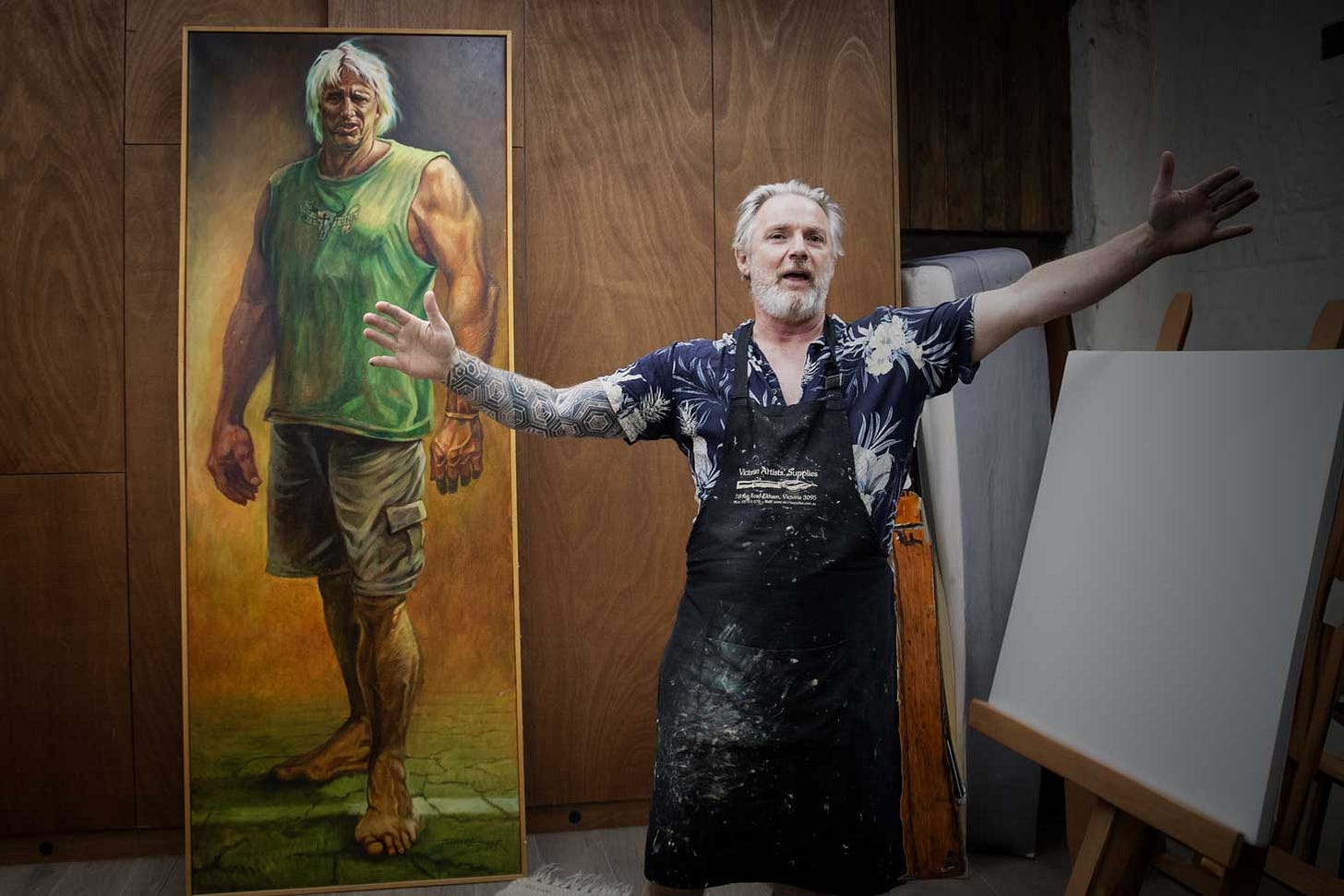

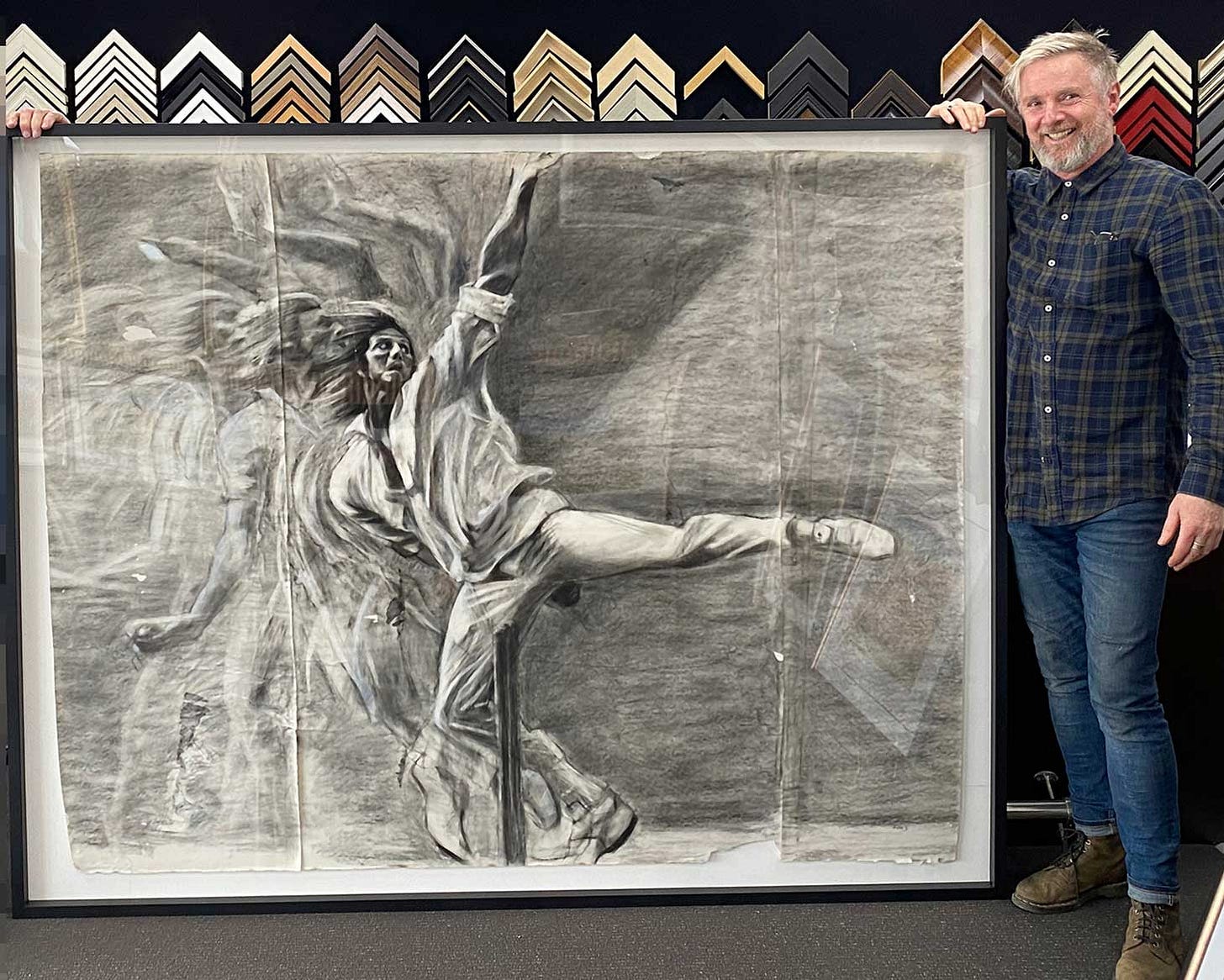
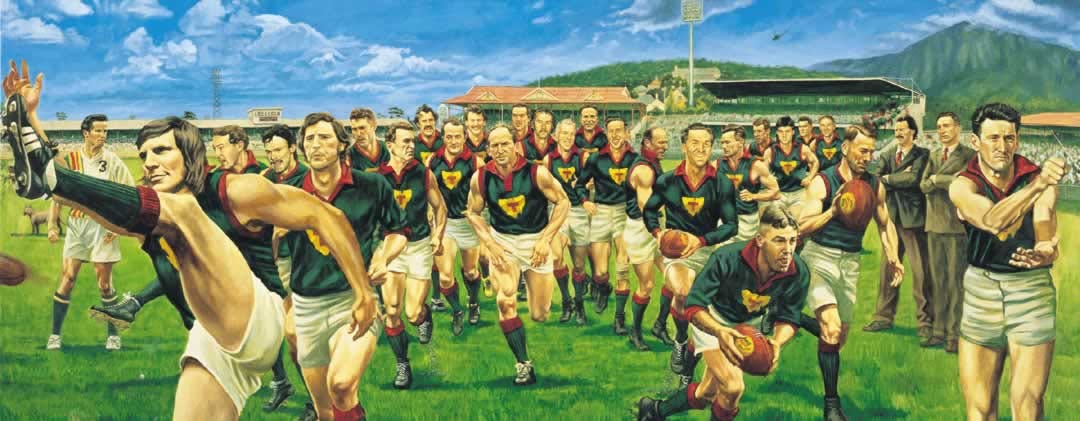
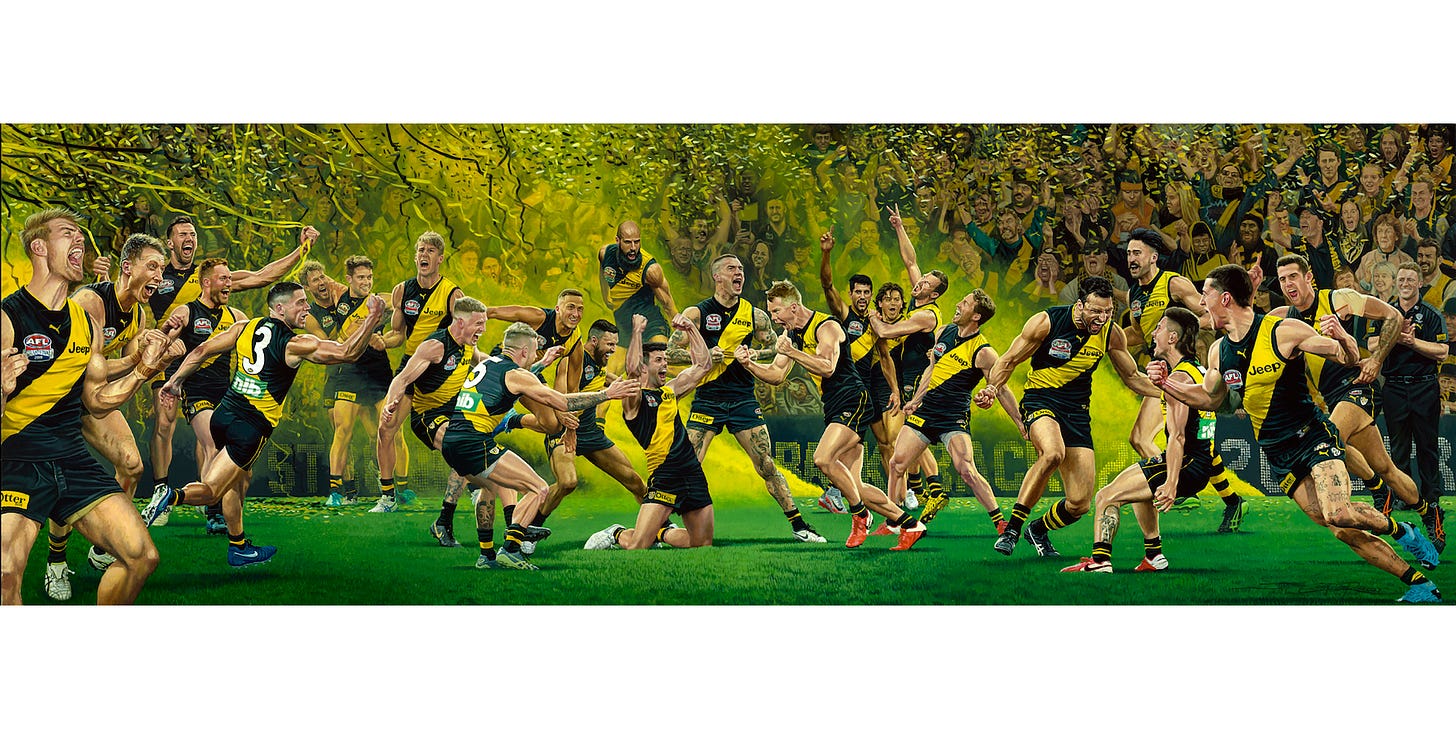


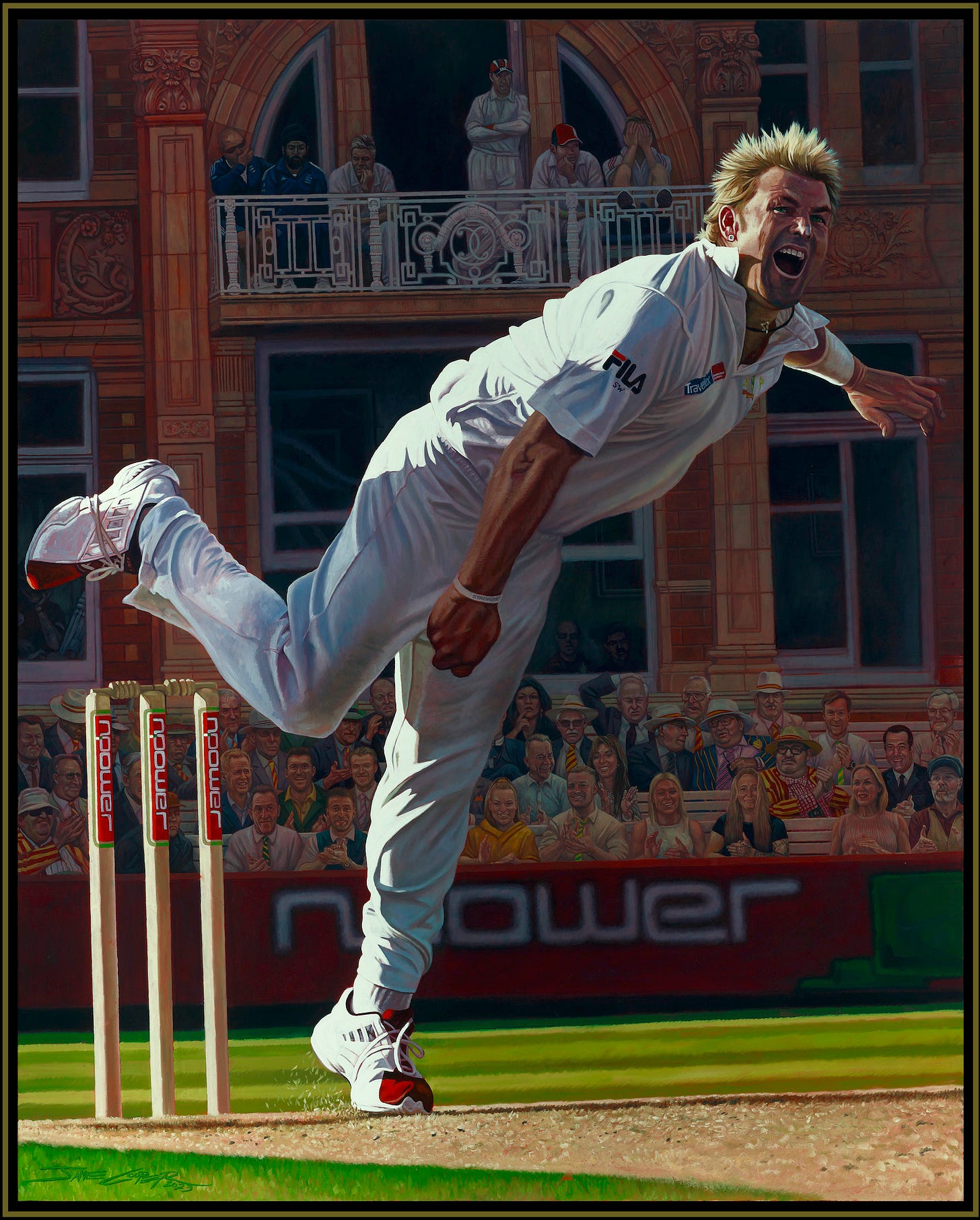
(Also as a boyhood fan of Thommo) I love both of Jamie's Thommo prints. Just brilliant.
Ripper yarn! And I reckon I saw him playing for the Lions…